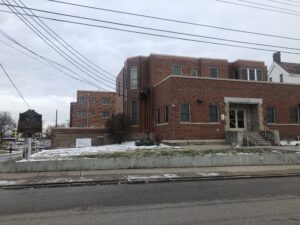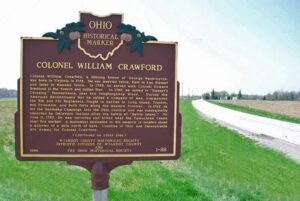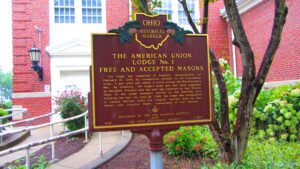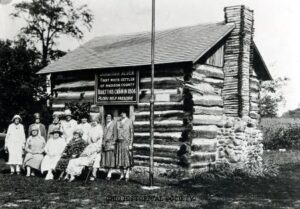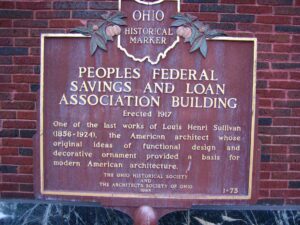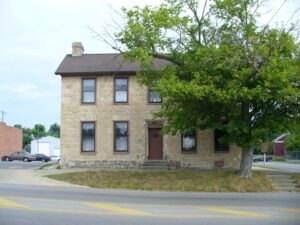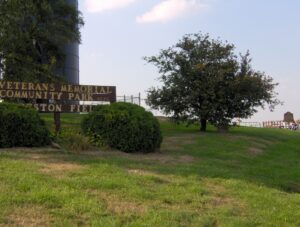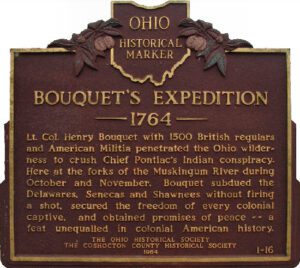, OH
Walnut Hills has been home to a significant middle- and working-class Black community since the 1850s. In 1931, African American entrepreneur Horace Sudduth bought 1004 Chapel Street and then the row of buildings across Monfort, naming them the Manse Hotel and Annex. Throughout the 1940s, hotel dinner parties could move to the Federation of Colored Women’s Clubs house next door for dancing. A large addition to the Manse in 1950 created its own ballroom, 24-hour coffee shop, upgraded Sweetbriar Restaurant, and more guest rooms. It appeared in the Negro Motorist’s Green Book between 1940-1963, providing local, transient, and residential guests both catered meetings and top entertainment during the last decades of segregation. It closed in the late 1960s when the economic need for a first-class segregated hotel disappeared in the age of Black Power.
, OH
Colonel William Crawford, a lifelong friend of George Washington, was born in Virginia in 1722. He was married twice, first to Ann Stewart and later to Hannah Vance. In 1755, he served with Colonel Edward Braddock in the French and Indian war. In 1767, he moved to “Stewart’s Crossing,” Pennsylvania, near the Youghiogheny River. During the Revolutionary War he raised a company of men, commanded the 5th and 7th Regiments, fought in battles in Long Island, Trenton, and Princeton, and built forts along the western frontier. In 1782, he led the Sandusky Campaign into the Ohio country and was subsequently captured by Delaware Indians after the battle of “Battle Island.” On June 11, 1782, he was tortured and killed near the Tymochtee Creek near this marker. A monument dedicated to his memory is located about a quarter mile north of here. Counties in Ohio and Pennsylvania are named for Colonel Crawford.
, OH
The lodge was organized in Roxbury, Massachusetts, on February 10, 1776, by Connecticut soldiers in the Continental Army. It met when and where it could during the Revolutionary War. By tradition, the lodge’s name and seal were suggested by Benjamin Franklin and the seal was engraved by Paul Revere. Many of the lodge members settled in the Marietta area following the war. On June 28, 1790, the lodge was reorganized in Campus Martius under its original warrant held by Past Master Capt. Jonathan Heart, commandant of Fort Harmer.
, OH
Seven-year-old Jonathan Alder was captured by a Native American war party in Virginia in 1782 and taken to a Mingo village north of the Mad River in Ohio where he was adopted by an Indian family. He remained with the Indians until after the 1795 Treaty of Greenville ended the Indian Wars in the Ohio Country. As white settlers entered the region, Alder frequently served as an interpreter. In 1805, he journeyed to Virginia and was reunited with his original family. He returned to Ohio with his new wife, Mary Blont, and built a cabin on Big Darby Creek. His cabin is now at the Madison County Historical Society Museum in London. Alder is buried in Foster Chapel Cemetery.
, OH
One of the last works of Louis Henri Sullivan (1856-1924), the American architect whose original ideas of functional design and decorative ornament provided a basis for modern American architecture.
, OH
The Smith Tannery is the oldest original structure remaining in Greenfield. Built in 1821 by Revolutionary War veteran William Smith and his son Samuel, the tannery became a noted station on the fabled “Underground Railroad.” The structure, which also served as the family residence, was the birthplace of Dr. Samuel M. Smith, Surgeon General of Ohio during the Civil War, and Dr. William R. Smith, who personally notified Abraham Lincoln of his nomination to the presidency in 1864. The Smiths were active members of the Abolition Society of Paint Valley, which was established in 1833 in Greenfield and reorganized in 1836 as the Greenfield Anti-Slavery Society. In 1844, the Society assisted the efforts of Frederick Douglass, one of the nation’s leading abolitionists. The Society provided an important junction on the Underground Railroad, assisting many fugitive slaves to gain freedom, including, it is said, Eliza Jane Harris of Uncle Tom’s Cabin fame. The Smith Tannery was named to the National Register of Historic Places in 1978.
, OH
With a population of 475 residents, the Beallsville community gained the unfortunate distinction of having suffered the highest known per-capita casualty rate during the Vietnam War. Six Beallsville men, all under the age of 21, were killed in action in Vietnam between 1966 and 1971, a profound tragedy for this close-knit community. In 1969 Beallsville citizens worked with congressional representatives to prevent further loss of life, to no avail. Five other Monroe County men lost their lives in the conflict as well, magnifying the loss for one of Ohio’s least-populated counties. (continued on other side)
, OH
Lt. Col. Henry Bouquet with 1500 British regulars and American militia penetrated the Ohio wilderness to crush Chief Pontiac’s Indian conspiracy. Here at the forks of the Muskingum River during October and November, Bouquet subdued the Delawares, Senecas, and Shawnee without firing a shot, secured the freedom of every colonial captive, and obtained promises of peace–a feat unequaled in colonial American history.


